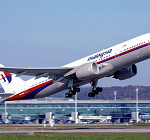Amidst all the talk about the missing Malaysian Airlines MH370 flight being hijacked for a possible September 11-style attack on an Indian city, it is necessary to look at the state of our security preparedness and whether India has adequate air defences to deal with such an aerial attack. [1]
Since the 2008 Mumbai attacks, a number of internal intelligence reports have mentioned the possibility of the next terror attack being from the skies. Corroborating these was the 2012 interrogation of the arrested Lashkar-e-Taiba operative and Mumbai attacks mastermind, Abu Jundal, which pointed out that terrorists were looking at using paragliders to carry out suicide attacks targeting vital installations on the Western seaboard – including our nuclear installations.
The likelihood of such an attack requires responses on two fronts:
a) Tactical – Strengthened air defences to prevent violation of Indian air space and fend off aerial attacks; and
b) Long term – Enhanced intelligence-sharing among the over 25 security agencies for proper analysis and dissemination of terror threat inputs, to ensure proper coordination on actionable intelligence that can foil terror attacks.
On the tactical front – protecting our airspace: we have learned well the lessons of the 9/11 attacks on the United States. To prevent airborne attacks either by a hijacked plane or a paraglider and other low-flying objects, the Indian Air Force has put in place a network of ground radars, early warning airborne systems and Unmanned Aerial Vehicles (UAVs) which can spot wayward movements. The security agencies have worked together to create ‘no-fly zones’ covering sensitive and vulnerable targets such as central Delhi and other important vital installations. To guard coastal and offshore installations like Bombay High, in recent years the Indian Navy has augmented its surveillance capability by inducting long-range patrolling aircraft and stepping up sorties by the UAVs.
But it is the other, more critical aspect – intelligence-sharing – where efforts to protect India not only from aerial but also land and sea-based terror attacks, lag behind. This is evident from the functioning of the Multi Agency Centre (MAC), which was created after the 2008 Mumbai attacks, and operates under the Ministry of Home Affairs.
The MAC brought together all the security agencies – those which provide threat inputs both technical and human intelligence, as also those which are to act on those threats. It created a system to expeditiously share threat inputs on any likely terror attack among the concerned agencies, and also to verify the reliability of the actual threat input.
In doing so, the MAC has achieved a lot.
But here’s the rub: in the critical matter of harnessing the intelligence and breaking down the high barriers between our two premier intelligence agencies – the Intelligence Bureau and the Research & Analysis Wing – the MAC has been less successful, even after five years of effort. On many occasions, this has seriously impaired India’s counter terrorism efforts and lost us critical leads on potential terror attacks. P. Chidambaram as Home Minister had envisioned making the MAC as powerful a body as the U.S. National Counter Terrorism Centre, but bureaucratic turf battles and recalcitrant state governments have so far defeated that worthy initiative and entrenched vested interests.
In a similar vein and at the state level, poor coordination between government agencies at the centre and state on intelligence-sharing has inhibited a robust response to terror threats. The MAC experience has revealed the dismal record of the local police forces in intelligence-gathering and processing of information. Barring notable exceptions, most state police units have not prioritised the provision of relevant information which can compliment or even fill the vacuum in the information provided by the central intelligence agencies.
Addressing the challenge of intelligence-gathering, improvement of police capabilities and ensuring better coordination between central and state government agencies, requires our political leaders to take a view independent of the vested interests.
The Congress-ruled coalition in Delhi began by implementing the right policies, but was unable to complete its task. Hopefully the next government will also treat this as a priority and despite its difficulty, upset the status quo.
Only then will we be viewed as a reliable counter-terrorism partner in the region, and at home, stand a reasonable chance of preventing and countering terrorist groups that, as the mystery of MH370 has shown, are always leagues ahead when they plan their attacks.
Sameer Patil is Associate Fellow, National Security, Ethnic Conflict and Terrorism, at Gateway House.
This article was exclusively written for Gateway House: Indian Council on Global Relations. You can read more exclusive content here.
For interview requests with the author, or for permission to republish, please contact outreach@gatewayhouse.in.
© Copyright 2014 Gateway House: Indian Council on Global Relations. All rights reserved. Any unauthorized copying or reproduction is strictly prohibited
Reference:
1. Talbott, Strobe (strobetalbott). “Malaysian plane mystery: Direction, fuel load & range now lead some to suspect hijackers planned a 9/11-type attack on an Indian city.” 15 March 2014, 10:38 a.m. Tweet.


